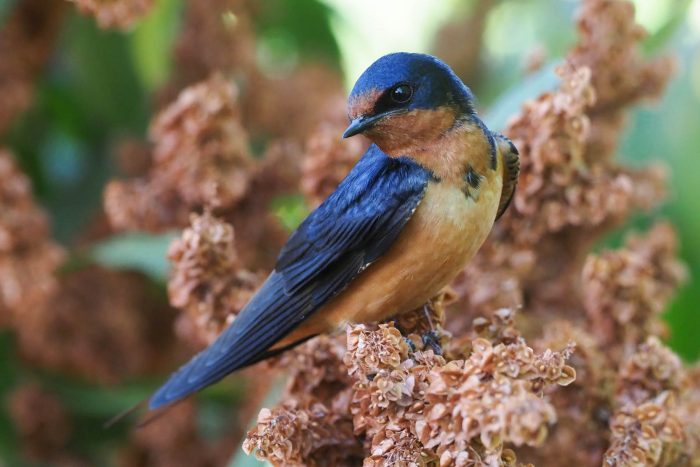Barn Swallow
Hirundo rustica
The barn swallow is a small, agile bird that visits open waters, wetlands and farm fields throughout the Chesapeake Bay region from spring through autumn.
This section shows one large critter image at a time. Use the thumbnails that follow to select a specific image to display here.

This gallery contains a grid of small thumbnails. Selecting a thumbnail will change the main image in the preceding section.
Appearance
The barn swallow has a steely, metallic blue back, wings and tail, with creamy beige underparts. It's throat and forehead are light brown or rust-colored. Females and juveniles are less boldly colored than adult males. Their tail is deeply forked with long outer feathers, and they have long, pointed wings. Barn swallows grow to between 5.5 and 7 inches in length with a wingspan of 12.5 to 13.5 inches.
Feeding
Barn swallows eat insects such as moths, flies, crickets, beetles and grasshoppers. They are often seen trailing behind farm tractors, feeding on plowed-up insects. They use their large, gaping mouths to catch insects while in flight and skim the surface of the water to drink while flying.
Predators
Nestlings have many predators, including gulls, rats, cats, squirrels and raccoons. Hawks, owls and falcons prey upon adults.
Flight
The barn swallow is an agile flyer that can quickly dive and turn while in the air. It often flies low over the water or land in search of insects.
Voice
Barn swallows sing a variety of calls, both as an individual and as a group. They also make a clicking noise by snapping their jaws together.
Reproduction and life cycle
Pairs form in spring, once the birds return to their breeding grounds. They build a nest of mud and plant materials, securely fastened to the wall of a barn or shed or the underside of a pier or bridge. Barn swallows can’t carry mud in their tiny claws, so males scoop up mud in their roomy beaks and bring it back to the female. The female lays an average of four brown-speckled white eggs, which she incubates for approximately two weeks. After hatching, the parents feed the nestlings. They often chirp while begging for food. Young begin flying three weeks later. Barn swallows usually live about four years, but can live as long as eight years.
Did you know?
- Barn swallows are the most abundant and widely distributed swallow species in the world.
- Other birds, often offspring from previous clutches, may help parents feed their young.
- The hat-making industry's impact on barn swallows prompted naturalist George Bird Grinnell to write an editorial denouncing the waste of bird life, which led to the founding of the first Audubon Society.
Sources and additional information
- Life in the Chesapeake Bay by Alice Jane Lippson and Robert L. Lippson
- Animal Diversity Web: Hirundo rustica – University of Michigan Museum of Zoology
- All About Birds: Barn Swallow – The Cornell Lab of Ornithology
